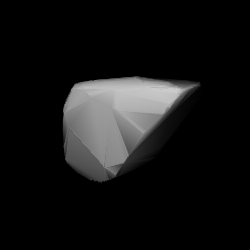astro.wikisort.org - Asteroid
1854 Skvortsov (prov. designation: 1968 UE1) is a stony background asteroid and relatively slow rotator from the middle region of the asteroid belt, approximately 9 kilometers in diameter. It was discovered on 22 October 1968, by Russian astronomer Tamara Smirnova at the Crimean Astrophysical Observatory in Nauchnyj on the Crimean peninsula.[7] It is named after astronomer Evgenii Skvortsov.[2]
 Shape model of Skvortsov from its lightcurve | |
| Discovery[1] | |
|---|---|
| Discovered by | T. Smirnova |
| Discovery site | Crimean Astrophysical Obs. |
| Discovery date | 22 October 1968 |
| Designations | |
MPC designation | (1854) Skvortsov |
Named after | Evgenii Skvortsov (astronomer)[2] |
Alternative designations | 1968 UE1 · 1962 HC 1964 VC · 1964 XB |
Minor planet category | main-belt · (middle)[3] |
| Orbital characteristics[1] | |
| Epoch 4 September 2017 (JD 2458000.5) | |
| Uncertainty parameter 0 | |
| Observation arc | 54.75 yr (19,999 days) |
| Aphelion | 2.8909 AU |
| Perihelion | 2.1855 AU |
Semi-major axis | 2.5382 AU |
| Eccentricity | 0.1390 |
Orbital period (sidereal) | 4.04 yr (1,477 days) |
Mean anomaly | 341.44° |
Mean motion | 0° 14m 37.32s / day |
| Inclination | 4.8987° |
Longitude of ascending node | 189.24° |
Argument of perihelion | 274.19° |
| Physical characteristics | |
| Dimensions | 8.97 km (calculated)[3] 9.602±0.095 km[4] 10.265±0.070 km[5] |
Synodic rotation period | 78.5±0.2 h[6] |
Geometric albedo | 0.20 (assumed)[3] 0.2031±0.0640[5] 0.252±0.053[4] |
Spectral type | S[3] |
Absolute magnitude (H) | 12.3[5] · 12.6[1][3] |
Orbit and classification
The asteroid orbits the Sun in the central main-belt at a distance of 2.2–2.9 AU once every 4.04 years (1,477 days). Its orbit has an eccentricity of 0.14 and an inclination of 5° with respect to the ecliptic.[1] Skvortsov was first observed at Goethe Link Observatory in 1962, when it was identified as 1962 HC, extending the body's observation arc by 6 years prior to its official discovery observation.[7]
Naming
This minor planet was named in honor of Evgenii Skvortsov (1882–1952), an instructor of astronomy in the Simferopol Pedagogical Institute, an active observer of minor planets at the Crimean Simeiz Observatory, and the discoverer of several minor planets, including 1149 Volga, 1167 Dubiago and 1381 Danubia.[2] The official naming citation was published by the Minor Planet Center on 1 June 1975 (M.P.C. 3825).[8]
Physical characteristics
Rotation period
In March 2006, a rotational lightcurve for Skvortsov was obtained from photometric observations made by American astronomer Brian D. Warner at his Palmer Divide Observatory in Colorado. It gave a rotation period of 78.5 hours with a brightness variation of 0.56 magnitude (U=2).[6] This is a rather slow rotation rate compared to the average asteroid spin of 2–20 hours.
Diameter and albedo
According to the survey carried out by NASA's Wide-field Infrared Survey Explorer with its subsequent NEOWISE mission, Skvortsov measures between 9.60 and 10.27 kilometers in diameter, and its surface has an albedo of 0.203 to 0.252.[4][5] The Collaborative Asteroid Lightcurve Link assumes a standard albedo for stony asteroids of 0.20 and calculates a diameter of 8.97 kilometers with an absolute magnitude of 12.6.[3]
References
- "JPL Small-Body Database Browser: 1854 Skvortsov (1968 UE1)" (2017-01-27 last obs.). Jet Propulsion Laboratory. Retrieved 8 June 2017.
- Schmadel, Lutz D. (2007). "(1854) Skvortsov". Dictionary of Minor Planet Names – (1854) Skvortsov. Springer Berlin Heidelberg. p. 149. doi:10.1007/978-3-540-29925-7_1855. ISBN 978-3-540-00238-3.
- "LCDB Data for (1854) Skvortsov". Asteroid Lightcurve Database (LCDB). Retrieved 13 December 2016.
- Masiero, Joseph R.; Grav, T.; Mainzer, A. K.; Nugent, C. R.; Bauer, J. M.; Stevenson, R.; et al. (August 2014). "Main-belt Asteroids with WISE/NEOWISE: Near-infrared Albedos". The Astrophysical Journal. 791 (2): 11. arXiv:1406.6645. Bibcode:2014ApJ...791..121M. doi:10.1088/0004-637X/791/2/121. Retrieved 13 December 2016.
- Mainzer, A.; Grav, T.; Masiero, J.; Hand, E.; Bauer, J.; Tholen, D.; et al. (November 2011). "NEOWISE Studies of Spectrophotometrically Classified Asteroids: Preliminary Results". The Astrophysical Journal. 741 (2): 25. arXiv:1109.6407. Bibcode:2011ApJ...741...90M. doi:10.1088/0004-637X/741/2/90.
- Warner, Brian D. (December 2006). "Asteroid lightcurve analysis at the Palmer Divide Observatory - February - March 2006". The Minor Planet Bulletin. 33 (4): 82–84. Bibcode:2006MPBu...33...82W. ISSN 1052-8091. Retrieved 13 December 2016.
- "1854 Skvortsov (1968 UE1)". Minor Planet Center. Retrieved 13 December 2016.
- Schmadel, Lutz D. (2009). "Appendix – Publication Dates of the MPCs". Dictionary of Minor Planet Names – Addendum to Fifth Edition (2006–2008). Springer Berlin Heidelberg. p. 221. doi:10.1007/978-3-642-01965-4. ISBN 978-3-642-01964-7.
External links
- Lightcurve plot of 1854 Skvortsov, Palmer Divide Observatory, B. D. Warner (2006)
- Asteroid Lightcurve Database (LCDB), query form (info Archived 16 December 2017 at the Wayback Machine)
- Dictionary of Minor Planet Names, Google books
- Asteroids and comets rotation curves, CdR – Observatoire de Genève, Raoul Behrend
- Discovery Circumstances: Numbered Minor Planets (1)-(5000) – Minor Planet Center
- 1854 Skvortsov at AstDyS-2, Asteroids—Dynamic Site
- 1854 Skvortsov at the JPL Small-Body Database
На других языках
[de] (1854) Skvortsov
(1854) Skvortsov ist ein Asteroid des Hauptgürtels, der am 22. Oktober 1968 von Tamara Michailowna Smirnowa im Krim-Observatorium entdeckt wurde.[1] Er wurde nach Jewgeni Fjodorowitsch Skworzow (1882–1952) benannt.[2]- [en] 1854 Skvortsov
[ru] (1854) Скворцов
(1854) Скворцов — один из астероидов главного пояса.Другой контент может иметь иную лицензию. Перед использованием материалов сайта WikiSort.org внимательно изучите правила лицензирования конкретных элементов наполнения сайта.
WikiSort.org - проект по пересортировке и дополнению контента Википедии